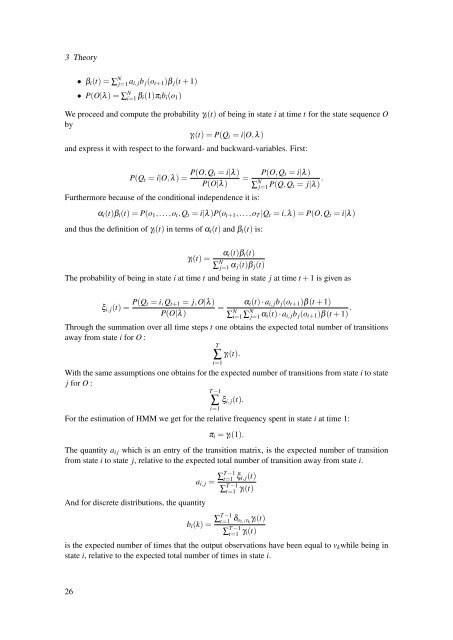Diffusion Processes with Hidden States from ... - FU Berlin, FB MI
Diffusion Processes with Hidden States from ... - FU Berlin, FB MI
Diffusion Processes with Hidden States from ... - FU Berlin, FB MI
You also want an ePaper? Increase the reach of your titles
YUMPU automatically turns print PDFs into web optimized ePapers that Google loves.
3 Theory• β i (t) = ∑ N j=1 a i, jb j (o t+1 )β j (t + 1)• P(O|λ) = ∑ N i=1 β i(1)π i b i (o 1 )We proceed and compute the probability γ i (t) of being in state i at time t for the state sequence Obyγ i (t) = P(Q t = i|O,λ)and express it <strong>with</strong> respect to the forward- and backward-variables. First:P(Q t = i|O,λ) = P(O,Q t = i|λ)P(O|λ)Furthermore because of the conditional independence it is:= P(O,Q t = i|λ)∑ N j=1 P(Q,Q t = j|λ) .α i (t)β i (t) = P(o 1 ,...,o t ,Q t = i|λ)P(o t+1 ,...,o T |Q t = i,λ) = P(O,Q t = i|λ)and thus the definition of γ i (t) in terms of α i (t) and β i (t) is:γ i (t) =α i(t)β i (t)∑ N j=1 α j(t)β j (t)The probability of being in state i at time t and being in state j at time t + 1 is given asξ i, j (t) = P(Q t = i,Q t+1 = j,O|λ)P(O|λ)=α i (t) · a i, j b j (o t+1 )β(t + 1)∑ N i=1 ∑ N j=1 α i(t) · a i, j b j (o t+1 )β(t + 1) .Through the summation over all time steps t one obtains the expected total number of transitionsaway <strong>from</strong> state i for O :Tγ i (t).∑t=1With the same assumptions one obtains for the expected number of transitions <strong>from</strong> state i to statej for O :T −1ξ i, j (t).For the estimation of HMM we get for the relative frequency spent in state i at time 1:∑t=1π i = γ i (1).The quantity a i j which is an entry of the transition matrix, is the expected number of transition<strong>from</strong> state i to state j, relative to the expected total number of transition away <strong>from</strong> state i.a i, j =And for discrete distributions, the quantityb i (k) =∑T−1t=1 ξ i, j(t)∑ T −1t=1 γ i(t)∑T−1t=1 δ o t, ,v kγ i (t)∑ T −1t=1 γ i(t)is the expected number of times that the output observations have been equal to v k while being instate i, relative to the expected total number of times in state i.26









